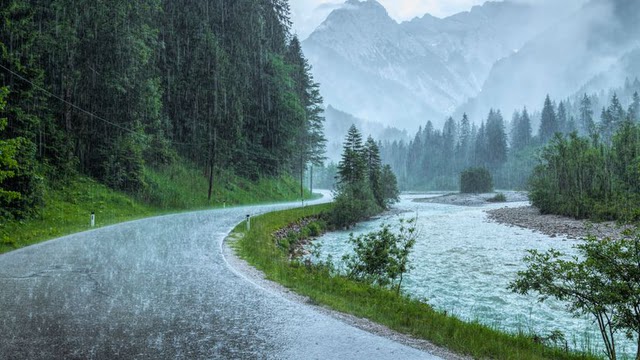Home Improvement

The rise in air pollution results in acid rain. It is necessary to find more environmentally friendly alternatives to replace nonrenewable fossil fuels. Thomas Winz / Getty Images
The world we inherited from our ancestors is different from the one we will pass on to our future generations. The excessive burning of nonrenewable fossil fuels in factories, power plants, and cars has resulted in acid rain pollution. Present-day precipitation contains high levels of sulfuric and nitric acid, which has devastating effects on our rivers, lakes, oceans, and the wildlife that resides within them [source: National Geographic]. Below are some tips that can help prevent acid rain pollution.
- Energy conservation is the most significant step you can take to prevent acid rain. Reduce your energy consumption by turning off lights when you leave a room, shutting down computers and televisions when not in use, and switching off electrical appliances when not in use. Your heating and cooling system consumes a significant amount of energy. Use air conditioning only when necessary, and turn down the heater’s thermostat when you leave the house. By doing so, you will save more energy and reduce energy bills [source: EPA].
- Transportation is a significant contributor to acid rain pollution. To reduce our reliance on fossil fuels, it is essential to look for alternative modes of transportation. Using public transit, carpooling, cycling, or walking can help reduce auto emissions. Try to avoid using your car as much as possible. By doing so, you will be helping the environment by preventing acid rain [source: National Geographic].
- Alternative fuels are an excellent way to prevent acid rain. Stop using nonrenewable fuels and switch to renewable energy sources such as solar, wind, and water energy. As technology advances, these alternative energies will become more readily available to the public. You can do your part for the environment by using solar-powered heating systems and battery-powered cars [source: EPA].
Originally Published: Jul 13, 2011
Questions and Answers about Acid Rain
Why is acid rain dangerous?
The use of non-renewable fossil fuels in factories, power plants, and vehicles leads to the formation of acid rain. This rain contains high levels of sulfuric and nitric acids, which cause harm to rivers, lakes, and oceans. It also affects the growth of trees by dissolving calcium and magnesium in the soil and releasing aluminum, which prevents trees from absorbing water.
How is acid rain created?
The release of sulfur dioxide and nitrogen oxides into the air leads to a chemical reaction that produces acid rain. These substances rise into the atmosphere and mix with water, oxygen, and other chemicals before falling to the ground as precipitation.
What can be done to prevent acid rain pollution?
Reducing the use of fossil fuels is the first step towards reducing pollution. Renewable sources of energy like solar and wind power should be used. Energy conservation should be prioritized by turning off lights and appliances when not in use. Carpooling and public transport can also help in reducing emissions.
What are the three harmful effects of acid rain?
Forests, soil quality, and natural water bodies are all negatively impacted by acid rain. This can be disastrous for animals, creatures, and humans.
What is the pH level of acid rain?
Acid rain has a pH value of around four.
FAQ
1. What is acid rain pollution?
Acid rain pollution is a term used to describe the deposition of acidic substances from the atmosphere onto the Earth’s surface. This can include rain, snow, fog, and even dry particles. It is caused by the emissions of sulfur dioxide and nitrogen oxides from burning fossil fuels, such as coal and oil, that react with water and oxygen in the atmosphere to form sulfuric acid and nitric acid.
2. What are the effects of acid rain pollution?
Acid rain pollution can have a range of negative effects on the environment, including damaging forests and crops, killing fish and other aquatic life, and eroding buildings and monuments. It can also contribute to respiratory problems in humans and animals, as well as harm soil and water quality.
3. How can individuals help prevent acid rain pollution?
Individuals can help prevent acid rain pollution by reducing their energy consumption. This can include using energy-efficient appliances, turning off lights and electronics when not in use, and reducing car use by walking, biking, or using public transportation. It is also important to properly dispose of hazardous chemicals, such as cleaning products, to prevent them from contributing to air pollution.
4. How can businesses help prevent acid rain pollution?
Businesses can help prevent acid rain pollution by implementing environmentally-friendly practices, such as using renewable energy sources and reducing emissions from manufacturing and transportation. They can also invest in technology that reduces emissions and encourages energy efficiency.
5. What is the government doing to prevent acid rain pollution?
The government has implemented regulations and laws to reduce emissions from factories, power plants, and other sources of pollution. This includes the Clean Air Act, which sets limits on sulfur dioxide and nitrogen oxide emissions, and the Acid Rain Program, which sets a cap on the amount of sulfur dioxide that can be emitted by power plants.
6. What are some alternative energy sources that can help prevent acid rain pollution?
Alternative energy sources, such as wind and solar power, can help prevent acid rain pollution by reducing the dependence on fossil fuels. Hydropower and geothermal energy are also clean energy sources that can help reduce emissions. Using these alternative energy sources can help reduce greenhouse gas emissions and prevent the formation of acid rain pollution.

Brody is a skilled craftsman and gardening expert. From renovating living spaces to cultivating lush gardens, Brody’s knowledge and passion shine through, inspiring readers to embark on their own home improvement and gardening journeys with confidence.






Leave a Reply